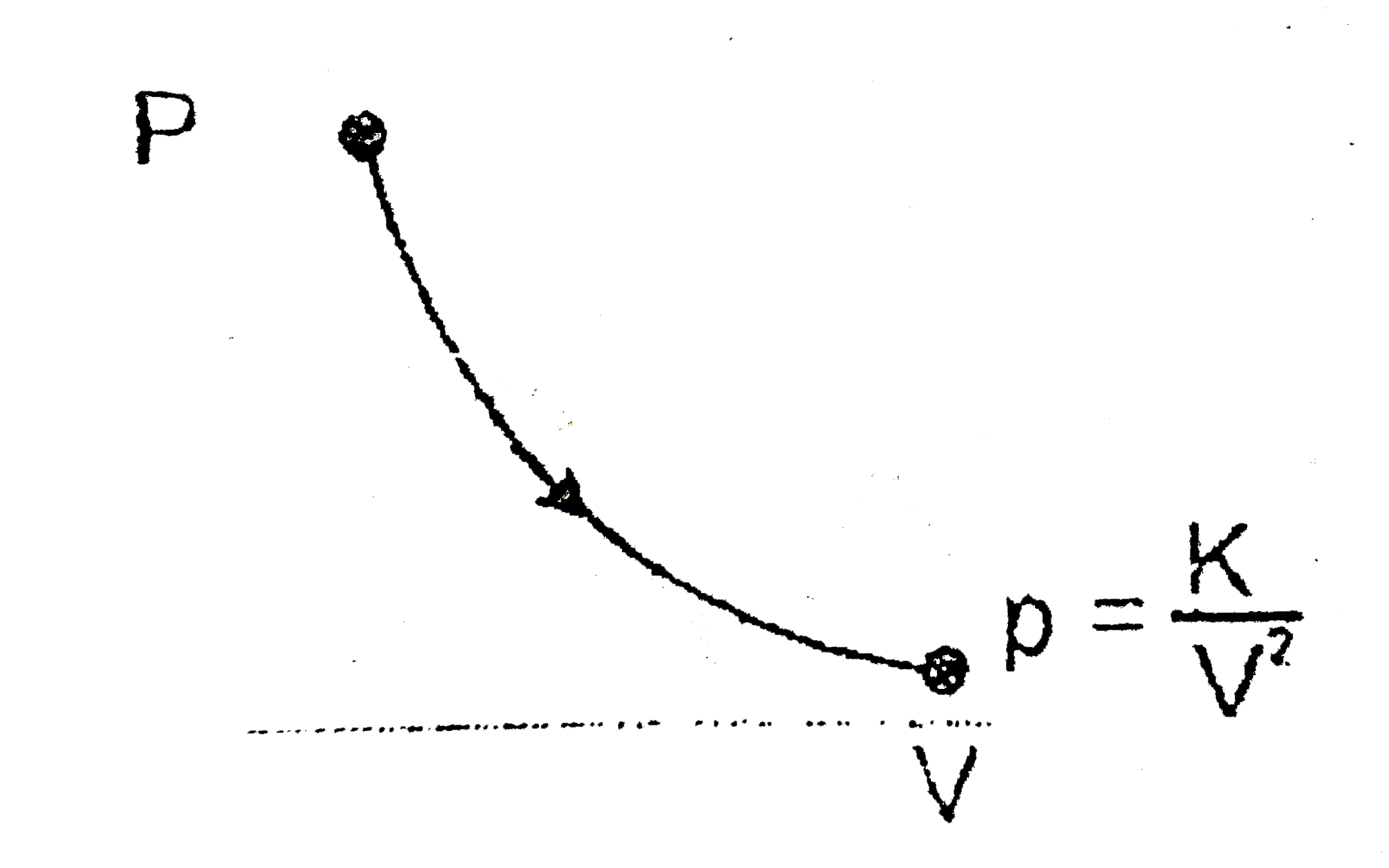A diatomic ideal gas is heated at constant volume until the pressure is doubled and again heated at constant pressure until the volume is doubled. The average molar heat capacity for the whole process is
13R6
19R6
23R6
17R6
The correct Answer is:B
To find the average molar heat capacity for the process described, we will break down the problem step by step.
Step 1: Define Initial Conditions
Let the initial state of the gas be defined as:
- Pressure at state 1: P1=P0
- Volume at state 1: V1=V0
- Temperature at state 1: T1=T0
Step 2: Process 1 to 2 (Constant Volume)
In this process, the gas is heated at constant volume until the pressure is doubled.
- Final pressure at state 2: P2=2P0
- Volume remains constant: V2=V0
Using the ideal gas law PV=nRT:
P2P1=T2T1⟹2P0P0=T2T0⟹T2=2T0
Step 3: Process 2 to 3 (Constant Pressure)
In this process, the gas is heated at constant pressure until the volume is doubled.
- Pressure remains constant: P3=P2=2P0
- Final volume at state 3: V3=2V0
Using the ideal gas law again:
V3V2=T3T2⟹2V0V0=T32T0⟹T3=4T0
Step 4: Calculate Heat Added in Each Process
1. Heat added in process 1 to 2 (constant volume):
Q1→2=nCV(T2−T1)=nCV(2T0−T0)=nCVT0
For a diatomic gas, CV=52R:
Q1→2=n(52R)T0
2. Heat added in process 2 to 3 (constant pressure):
Q2→3=nCP(T3−T2)=nCP(4T0−2T0)=nCP(2T0)
For a diatomic gas, CP=72R:
Q2→3=n(72R)(2T0)=n(7R)T0
Step 5: Total Heat Added
The total heat added during the entire process is:
Qtotal=Q1→2+Q2→3=n(52RT0)+n(7RT0)
Combining the terms:
Qtotal=n(52RT0+7RT0)=n(52RT0+142RT0)=n(192RT0)
Step 6: Average Molar Heat Capacity
The average molar heat capacity Cavg for the entire process is given by:
Cavg=QtotalΔT
Where ΔT=T3−T1=4T0−T0=3T0:
Cavg=n(192RT0)3T0=196R
Final Answer
The average molar heat capacity for the whole process is:
Cavg=196R
Let the initial state of the gas be defined as:
- Pressure at state 1: P1=P0
- Volume at state 1: V1=V0
- Temperature at state 1: T1=T0
In this process, the gas is heated at constant volume until the pressure is doubled.
- Final pressure at state 2: P2=2P0
- Volume remains constant: V2=V0
P2P1=T2T1⟹2P0P0=T2T0⟹T2=2T0
In this process, the gas is heated at constant pressure until the volume is doubled.
- Pressure remains constant: P3=P2=2P0
- Final volume at state 3: V3=2V0
V3V2=T3T2⟹2V0V0=T32T0⟹T3=4T0
1. Heat added in process 1 to 2 (constant volume):
Q1→2=nCV(T2−T1)=nCV(2T0−T0)=nCVT0
For a diatomic gas, CV=52R:
Q1→2=n(52R)T0
Q2→3=nCP(T3−T2)=nCP(4T0−2T0)=nCP(2T0)
For a diatomic gas, CP=72R:
Q2→3=n(72R)(2T0)=n(7R)T0
The total heat added during the entire process is:
Qtotal=Q1→2+Q2→3=n(52RT0)+n(7RT0)
Combining the terms:
Qtotal=n(52RT0+7RT0)=n(52RT0+142RT0)=n(192RT0)
The average molar heat capacity Cavg for the entire process is given by:
Cavg=QtotalΔT
Where ΔT=T3−T1=4T0−T0=3T0:
Cavg=n(192RT0)3T0=196R
The average molar heat capacity for the whole process is:
Cavg=196R
Topper's Solved these Questions
- KINETIC THEORY OF GASES AND FIRST LAW OF THERMODYNAMICSBook:CENGAGE PHYSICS ENGLISHChapter:KINETIC THEORY OF GASES AND FIRST LAW OF THERMODYNAMICSExercise:Multiple Corrects
Explore 29 Videos
- KINETIC THEORY OF GASES AND FIRST LAW OF THERMODYNAMICSBook:CENGAGE PHYSICS ENGLISHChapter:KINETIC THEORY OF GASES AND FIRST LAW OF THERMODYNAMICSExercise:Assertion-Reasoning
Explore 6 Videos
- KINETIC THEORY OF GASES AND FIRST LAW OF THERMODYNAMICSBook:CENGAGE PHYSICS ENGLISHChapter:KINETIC THEORY OF GASES AND FIRST LAW OF THERMODYNAMICSExercise:Subjective
Explore 22 Videos
- KINETIC THEORY OF GASESBook:CENGAGE PHYSICS ENGLISHChapter:KINETIC THEORY OF GASESExercise:Compression
Explore 2 Videos
- LINEAR AND ANGULAR SIMPLE HARMONIC MOTIONBook:CENGAGE PHYSICS ENGLISHChapter:LINEAR AND ANGULAR SIMPLE HARMONIC MOTIONExercise:Single correct anwer type
Explore 14 Videos
Similar Questions
A diatomic ideal gas is heated at constant at constant volume until the pressure is doubled and again heated of constant pressure until the volume is doubled. The average molar heat capacity for the whole process is
View SolutionA diatomic ideal gas is heated at constant at constant volume until the pressure is doubled and again heated of constant pressure until the volume is doubled. The average molar heat capacity for the whole process is
View SolutionA monatomic ideal gas is heated at constant volume until its pressure is doubled. It is again heated at constant pressure, until its volume is doubled. Find molar specific heat for the whole process.
View SolutionA diatomic ideal gas is heated at constant volume until its pressure becomes three times. It is again heated at constant pressure until its volume is doubled. Find the molar heat capacity for the whole process.
View SolutionIf an ideal gas is heated at constant pressure :
View SolutionWhen a gas is heated in a vessel of constant volume , the pressure increases because
View SolutionFor an ideal gas, the heat capacity at constant pressure is larger than than that at constant volume because
View SolutionHeat supplied to an ideal gas sample at constant Pressure :
View SolutionThe molar heat capacity for the process shown in fig. is

View SolutionThe molar heat capacity for a gas at constant T and P is
View Solution
